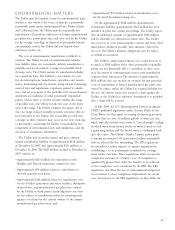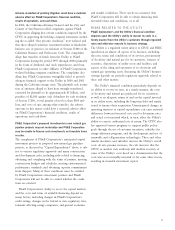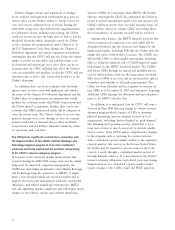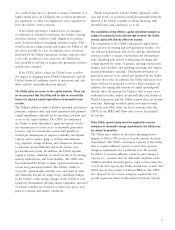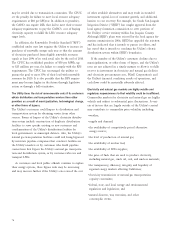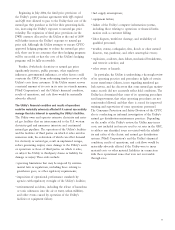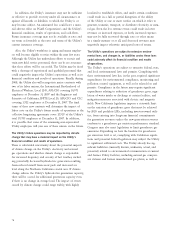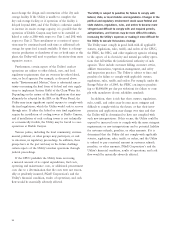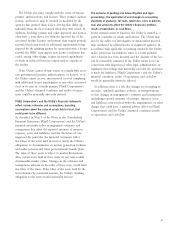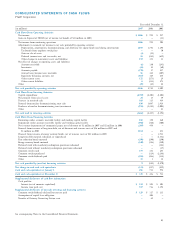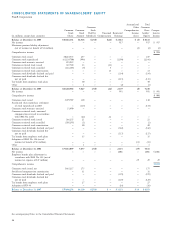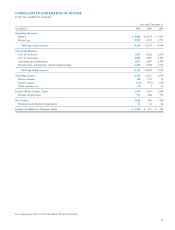PG&E 2007 Annual Report Download - page 79
Download and view the complete annual report
Please find page 79 of the 2007 PG&E annual report below. You can navigate through the pages in the report by either clicking on the pages listed below, or by using the keyword search tool below to find specific information within the annual report.77
Beginning in July 2006, the fi xed price provisions of
the Utility’s power purchase agreements with QFs expired
and QFs were allowed to pass to the Utility their cost of the
natural gas they purchase as fuel for their generating facili-
ties, increasing the Utility’s exposure to natural gas price
volatility. The expiration of fi xed price provisions in the
DWR contracts allocated to the Utility at the end of 2009
will further increase the Utility’s exposure to natural gas
price risk. Although the Utility attempts to execute CPUC-
approved hedging programs to reduce the natural gas price
risk, there can be no assurance that these hedging programs
will be successful or that the costs of the Utility’s hedging
programs will be fully recoverable.
Further, if wholesale electricity or natural gas prices
signifi cantly increase, public pressure, other regulatory
infl uences, governmental infl uences, or other factors could
constrain the CPUC from authorizing timely recovery of the
Utility’s costs from customers. If the Utility cannot recover
a material amount of its costs in its rates in a timely manner,
PG&E Corporation’s and the Utility’s fi nancial condition,
results of operations, and cash fl ows would be materially
adversely affected.
The Utility’s fi nancial condition and results of operations
could be materially adversely affected if it cannot successfully
manage the risks inherent in operating the Utility’s facilities.
The Utility owns and operates extensive electricity and natu-
ral gas facilities that are interconnected to the U.S. western
electricity grid and numerous interstate and continental
natural gas pipelines. The operation of the Utility’s facilities
and the facilities of third parties on which it relies involves
numerous risks, the realization of which can affect demand
for electricity or natural gas, result in unplanned outages,
reduce generating output, cause damage to the Utility’s assets
or operations or those of third parties on which it relies,
or subject the Utility to third-party claims or liability for
damage or injury. These risks include:
• operating limitations that may be imposed by environ-
mental laws or regulations, including those relating to
greenhouse gases, or other regulatory requirements;
• imposition of operational performance standards by
agencies with regulatory oversight of the Utility’s facilities;
• environmental accidents, including the release of hazardous
or toxic substances into the air or water, urban wildfi res,
and other events caused by operation of the Utility’s
facilities or equipment failure;
• fuel supply interruptions;
• equipment failure;
• failure of the Utility’s computer information systems,
including those relating to operations or fi nancial infor-
mation such as customer billing;
• labor disputes, workforce shortage, and availability of
qualifi ed personnel;
• weather, storms, earthquakes, fi res, fl oods or other natural
disasters, war, pandemic, and other catastrophic events;
• explosions, accidents, dam failure, mechanical breakdowns,
and terrorist activities; and
• other events or hazards.
In particular, the Utility is undertaking a thorough review
of its operating practices and procedures in light of certain
recent transformer failures, issues regarding mandated gas
leak surveys, and the discovery that some natural gas mainte-
nance records did not accurately refl ect fi eld conditions. The
Utility has determined that some of its operating procedures
need improvement, that other operating procedures are not
consistently followed, and that there is a need for improved
training and supervision of some operations personnel.
The Consumer Protection and Safety Division of the CPUC
also is conducting an informal investigation of the Utility’s
natural gas distribution maintenance practices. Depending
on the results of the Utility’s review, the Utility may incur
costs, not included in forecasts used to set rates in the GRC,
to address any identifi ed issues associated with the reliabil-
ity and safety of the electric and natural gas distribution
systems. PG&E Corporation’s and the Utility’s fi nancial
condition, results of operations, and cash fl ows would be
materially adversely affected if the Utility were to incur
material costs or other material liabilities in connection
with these operational issues that were not recoverable
through rates.




